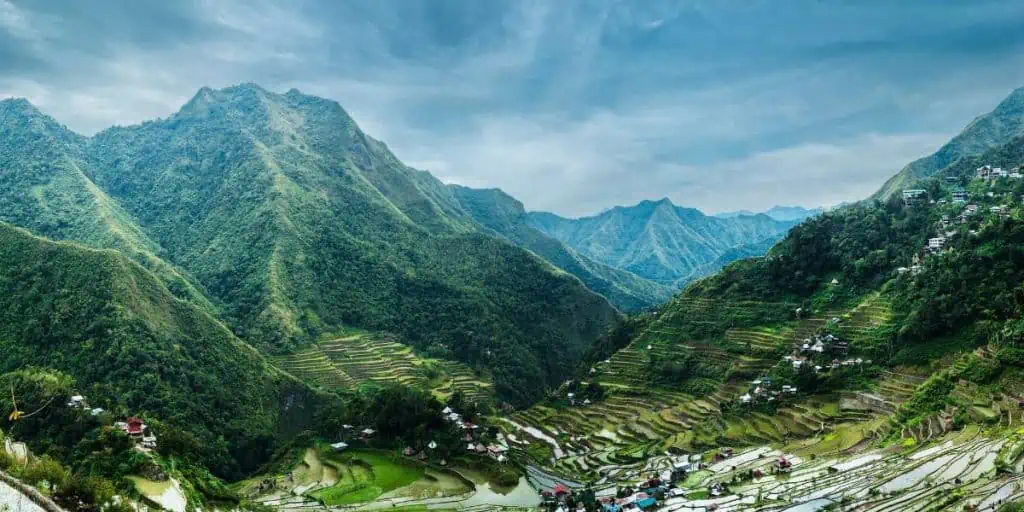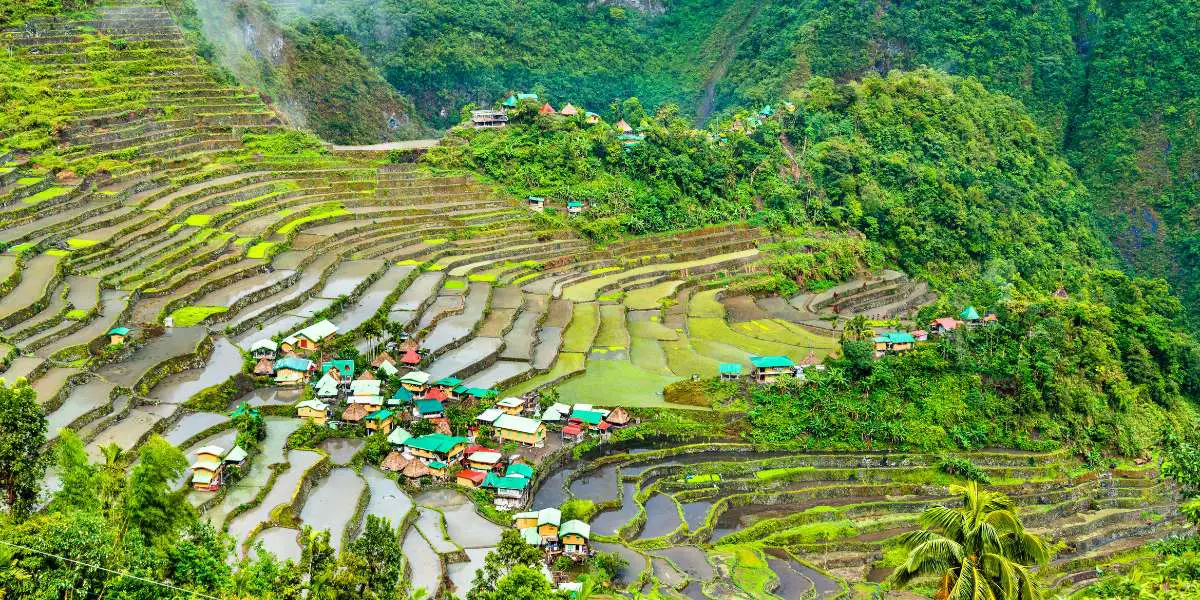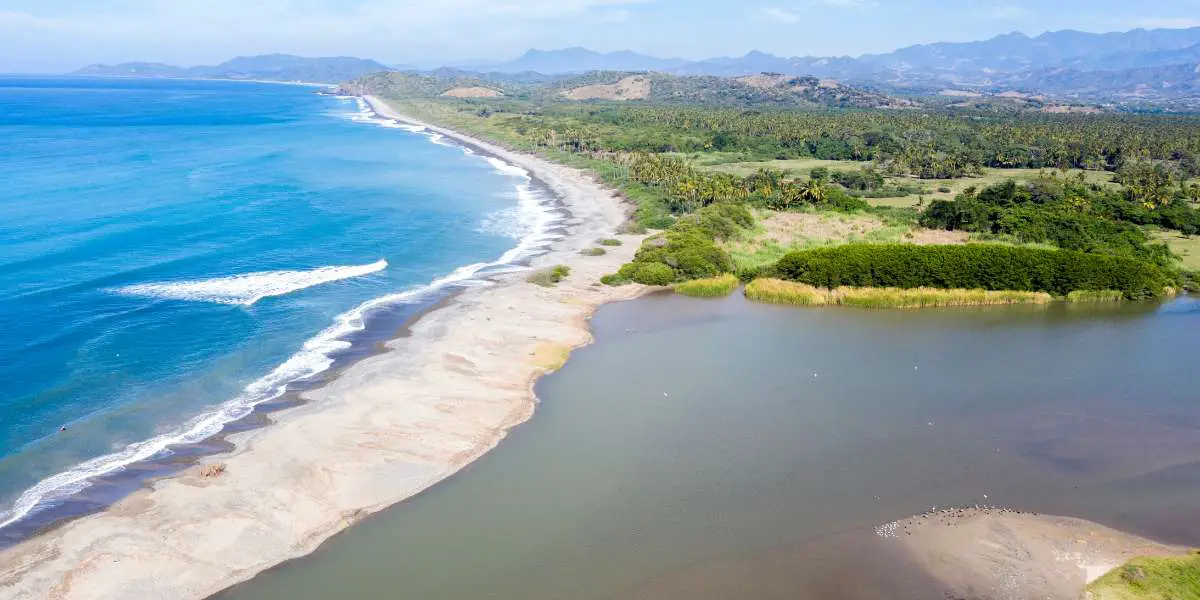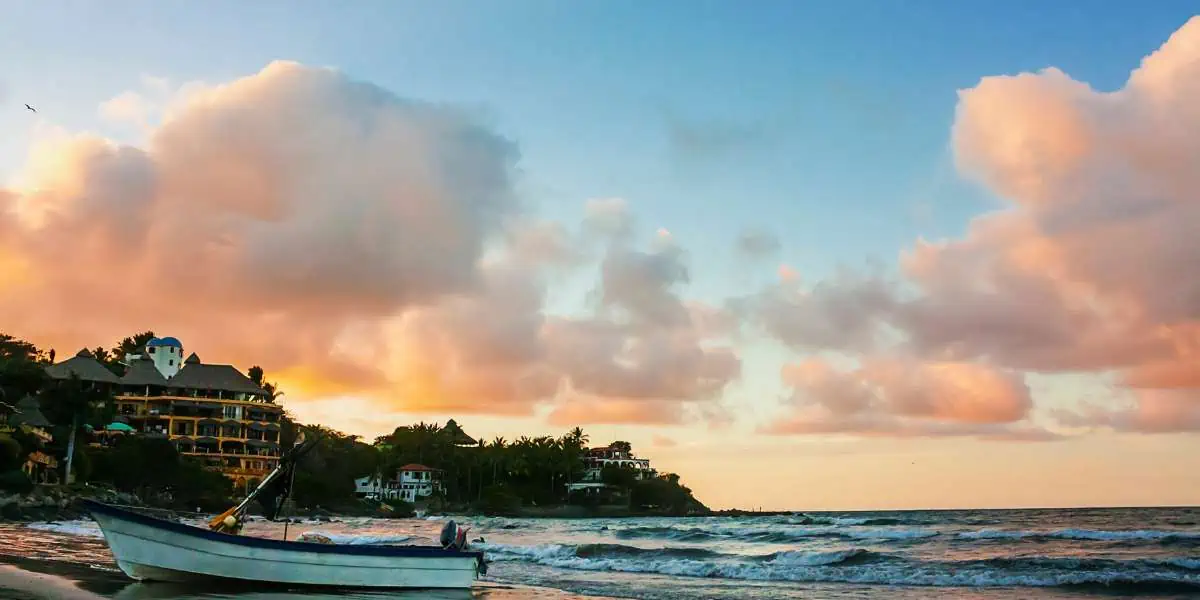Discover the awe-inspiring Batad Rice Terraces in the Philippines’ Cordillera mountains – a UNESCO World Heritage Site boasting over 2,000 years of history and providing sustenance and livelihood to the Ifugao people.
Embark on an unforgettable journey and immerse yourself in the intricate layers of rice paddies cascading down the verdant slopes while learning about the Ifugao’s remarkable harmony with nature.
A Captivating Introduction
Nestled high in the rugged Cordillera Central mountain range in the northern Philippines lies one of the most extraordinary destinations in the world – the spellbinding Batad Rice Terraces. Carved into the steep slopes and ringing the Amphitheater village of Batad like a giant emerald necklace, these ancient stairways to the sky are a sight to behold.
Recognized as a UNESCO World Heritage Site, the Batad Rice Terraces showcase the Ifugao ethnic minority group’s mastery of sustainable engineering and bear testament to the human ability to adapt and thrive in even the most challenging environments.
Dating back over 2,000 years, the ingenious terraces follow the contours of the Cordillera mountains, cascading down the breathtaking slopes in curvaceous patterns like giant zen gardens. This intricate network of stone walls and irrigation channels transforms vertiginous gradients into productive rice paddies that have sustained generations of Ifugaos.
More than just feats of agricultural engineering, these lush cascading terraces intersect harmoniously with picturesque Ifugao hamlets perched seemingly precariously on ridges and valleys to form an inextricable link between culture and landscape.
Let’s delve deeper into the history, construction, and significance of the UNESCO-recognized Batad Rice Terraces – striking examples of the human ability to adapt, thrive, and create functional beauty, even under the most difficult conditions.
The Origins and History of Batad’s Rice Terraces
The exact origins of Batad’s ancient rice terraces have been lost to the mists of time but their beginnings most likely date back over 2,000 years to when wet-rice cultivation first spread across Asia.
Oral tradition suggests the ingenious stepped paddies found throughout the Ifugao region first emerged between 300-400 years ago as the ancestors of modern-day indigenous tribes migrated northwards from southern China in search of productive farming land.
Facing the challenge of carving out a living in the unforgiving terrain of the steeply sloped Cordillera mountains, early Ifugaos used basic tools of wood, stone, and bone to painstakingly construct free-standing retaining walls reinforced with rocks and tree trunks.
They filled the spaces behind with layers of clay and topsoil hauled up from the valley below to transform dangerously vertiginous mountain gradients into cascading sequences of productive wet-rice terraces. The hardy and drought-resistant tinawon rice variety was cultivated to withstand the extreme conditions.
The remote Amphitheater village of Batad nestled in the UNESCO-listed Ifugao Rice Terraces offers some of the most dramatic glimpses into this ancient farming legacy that has endured for centuries.
Over time these feats of agricultural engineering have become inextricably interwoven with Ifugao cultural identity and traditional religious beliefs rooted in a harmonious co-existence with nature and the spiritual world. The rice terraces and their continued cultivation reinforce this profound connection.
The Intricate Construction of Batad’s Terraces
Constructing and maintaining the UNESCO-recognized Batad Rice Terraces demonstrates the extraordinary ingenuity, resilience and deep knowledge of sustainable land management practices inherent in Ifugao indigenous culture.
Built entirely by hand using simple farming implements, the terraces exemplify the mastery of ecological engineering principles honed over generations. Their longevity and continued functionality in the face of modern challenges are a testament to the wisdom passed down by Ifugao ancestors.
The foundational retaining walls that structure the rice terraces were fashioned from packed earth cut and compacted into shapes stabilized by rock reinforcements and buttresses made of tree trunks and woven branches.
These were packed layer by layer with soil hauled laboriously to the site in large rattan baskets suspended on bamboo poles and carried on the backs of Ifugao workers via an intricate network of narrow footpaths cut along steep ridges.
The terraced paddies cascade perfectly down the undulating slopes following the natural contours. An ingenious community-based irrigation system utilizing bamboo pipes directs water drained from the rainforest higher up to flow continuously from terrace to terrace.
Traditionally tending the fragile terraces required extensive manpower with village members mobilizing annually to reconstruct damaged retaining walls and irrigation channels before the planting season.
The Herculean effort and unwavering dedication, generation after generation, to maintain these engineering marvels reflect the pivotal role of rice cultivation in Ifugao culture – providing sustenance and a profound connection with nature and ancestral heritage.
Physical Characteristics: Emerald Necklaces Cascading Down Verdant Slopes
The UNESCO-inscribed Batad Rice Terraces are integrals parts of the picturesque mountainscapes characteristic of the Ifugao’s ancestral domain in the northern Philippines.
Resembling gigantic emerald necklaces draped gracefully around the Cordillera peaks and valleys, the ancient terraces transform perilously steep gradients into undulating stepped plains that ripple outwards across the slopes.
The amphitheater village of Batad, accessible only by a lengthy mountain trek, is completely encircled by rows upon rows of these verdant man-made landscapes. Stone retaining walls divide the mountainside into cascading sequences of terraced pools shimmering like jade and flowing seamlessly into one another.
During the planting season, mirrored reflections of billowing clouds and the rainforest canopy glide silently across the tranquil water surfaces of the rice terraces’ paddies.
While to the casual observer, the terraces appear almost organic like naturally occurring formations, their ingenious functionality reflects sophisticated planning, precision layout, and mastery over sustainable engineering that has endured over two millennia.
The harmonious balance between human design and ecological processes is evident in the self-contained irrigation system, the responsive water storage capacity protecting paddies from floods and droughts, and the cultivation of heritage upland rice varieties – all resonating with the beliefs of Ifugao elders who view the terraces as gifts from ancestral gods.
Cultural Significance: Sustenance, Livelihood and Identity

Beyond their status as UNESCO-recognized feats of ancient engineering, the Batad Rice Terraces hold profound cultural meaning for the indigenous Ifugao communities as sources of sustenance, economic livelihood and ethnic identity and belief systems for over two millennia.
Providing up to five rice harvests annually, the terraces enable secure yields of the Ifugao’s staple crop with their sophisticated irrigation and drainage systems protecting against erratic weather patterns and the looming threat of climate change.
The nutritional value and symbolic status of rice as the core element of Ifugao rituals and rites of passage make the continued cultivation of heritage heirloom varieties in the ancestral terraces pivotal to cultural preservation and sense of self.
Rice terracing defines gender roles and binds families, with the arduous construction and upkeep of Batad’s World Heritage terraces requiring extensive communal efforts spanning generations. The rhythms of preparing, sowing, transplanting, harvesting and storing rice shape the Ifugao’s seasonal calendars.
Oral histories recounting the origins of Batad’s terraces and the deities believed to inhabit the landscapes reinforce the sacred significances and sense of enduring permanence inherent in these cultural treasures which hold the history of Ifugao resilience and harmony with nature.
Their very existence over two millennia is seen by indigenous elders as proof of the favor of ancestral gods upholding this symbiotic relationship between the Ifugao farmers and the life-giving terraces in a mutual cycle of stewardship and gratitude.
When to Visit These UNESCO Marvels
While scenic at any time of year, visiting the UNESCO-listed Batad Rice Terraces is especially memorable during planting and harvest seasons when the slopes come alive with the colors, sounds and industry of rice cultivation.
The Ifugao follow a sustainable crop rotation farming schedule perfectly adapted to the Cordillera’s rainy season from May to October interspersed with dry winters. Below are suggested ideal times to experience the living cultural heritage of Batad’s terraces.
May: spectacular valley views after the dry season coupled with community rituals before the heavy farming activities. Witness age-old religious ceremonies related to rice cultivation led by village elders and enjoy cultural performances of traditional music and dances as the Ifugaos give thanks for the bounty to come.
June-July: rice shoots carpeting the terraces in vibrant green during planting season. Watch families with infants wrapped to their mothers’ backs bending over paddies, plucking and bundling tiny rice stalks while ankle-deep in muddy water under the tropical sun. Gain insight into Ifugao farming techniques perfected over generations.
September-October: golden panoramas during harvest time with indigenous farmers beating stalks or operating hand-turned milling machines to separate the grains. The terraces shimmer like gold dust swirling in mountains as the precious rice ripens under blue skies. Sample the nutty aroma of the indigenous unpolished heirloom rice varieties during village harvest festivals and lend a hand to reap bundles bursting with glistening grains.
November-April: fallow season offers unique bird watching and hiking opportunities through sleepy terraces in dreaming mode. With paddies drained and planted areas lying dormant, enjoy leisurely strolls along the stone walls while spotting vibrant kingfishers, bush-chats and flowerpeckers that flock here during the winter months. The cool, off-peak season also draws adventure enthusiasts eager to trek Ifugao’s ancient spider-web of stair-like foot trails across empty rice terraces resembling giant zen gardens in hues of brown and gold.
Regardless of timing, travelers should check for village-hosted cultural celebrations as the Ifugaos observe an agricultural calendar woven intricately with spiritual beliefs and superstitions unique to each picturesque hamlet tucked secretly into the magnificent rice terraces.
Immersing in Ifugao Culture and Traditions
Beyond merely gazing in awe at their beauty, the best way to fully appreciate the living heritage of Batad’s rice terraces is to immerse in authentic experiences of time-honored Ifugao traditions centered around rice cultivation and indigenous wisdom nurtured over generations.
Stay in a traditional Ifugao hut and observe indigenous architecture perfected to withstand frequent earthquakes yet blending seamlessly with the terraced landscapes. Study the sustainable materials from which these heritage homes were constructed without nails or metal while nestling organically amongst the paddies.
Rise before dawn with indigenous farmers to hike centuries-old mountain trails edged by sleeping terraces as shadows slowly unveil. Learn how to plant rice stalks bundled from the previous season in ankle-deep pools under the tutelage of village elders eager to impart ancient wisdom.
Watch the hypnotic choreography of buffaloes plowing paddies directed only by the occasional murmur from barefoot farmers. Marvel at the intimate relationship between man and beast as gentle giants with crescent horns labeled with tribal symbols turn sodden earth ready for delicate rice shoots.
Savor home-cooked Ifugao cuisine bursting with nutty indigenous red and heirloom black rice paired with spicy fermented sausages and green papaya salads featuring foraged mountain ferns and bitter gourds – all ingredients harvested from nearby heirloom terraces and lush forests.
Connect with an indigenous village shaman practicing ancient arts of herbal healing, divination and cleansing rituals passed down orally through generations. Gain insight into Ifugao spirituality and how harmonious balance with nature ensures the enduring legacy of the sacred terraces crafted by ancestral gods as gifts for their human children.
Preserving Ifugao’s Heirloom Terraces
While the Batad Rice Terraces, inscribed on UNESCO World Heritage lists, have endured over two millennia, preserving them for the future has become an urgent priority as climate change, outmigration and tourism pressures threaten these living cultural treasures.
Once self-contained bustling Ifugao hamlets are now shadow villages held together by only a few elderly inhabitants as younger generations abandon physically taxing rice farming for urbanized cities. Neglected walls and irrigation channels crumble as extreme weather events and dropping water levels struggle to support even hardy heirloom varieties.
Infrastructure catering to booming tourism strains natural resources as visitor numbers outstrip capacity, tipping the ecological balance that historically nurtured harmonious human co-existence with the terraces. Indigenous voices also lament the erosion of Ifugao cultural identity and sustainable practices as creeping modernization alters their symbiotic relationship of stewardship with the land.
Yet all is not lost. Heartening movements to safeguard Batad’s breathtaking terraces for posterity signal flickering hope as global recognition of their outstanding significance offers a lifeline for preservation.
Ifugao elders eagerly share ethnobotanical knowledge with visiting anthropologists documenting intricate spiritual beliefs and indigenous cultigens – all helping to revive endangered traditions. Voluntourism networks mobilize visitors as terrace guardians, either funding farmers directly or contributing manual labor during annual rebuilding efforts that bind communities.
Growing realization of the treasures in their midst also slowly awakens younger Ifugaos to rediscover pride in their heritage, some choosing to stay back as torchbearers of age-old practices. Their nascent advocacy for indigenous land rights empowers the community to have a voice in modernization policies impacting their fragile terraces.
Yet the ultimate salvation of Batad’s ancient marvels rests in our collective commitment to preserve this unique confluence of nature and human ingenuity – glistening emerald showcases of the heights to which the human spirit can soar when striking a profound harmony with the environment.
Will you join in scripting the next resilient chapter for these living global treasures – our bridge between past and future?
In Summary
The captivating UNESCO World Heritage site of the Batad Rice Terraces blooms like giant jade necklaces draped around the Amphitheater village in the Philippine’s Cordillera mountains.
Boasting over 2,000 years of history, these feats of agricultural engineering reflect indigenous Ifugao ingenuity in transforming perilous mountain gradients into cascading stairways of productive wet-rice cultivation that continues to sustain communities clinging to ancestral traditions.
Beyond engineering marvels, the enduring terraces represent the harmony between indigenous culture and ecosystems nurtured generation after generation. Their very existence binds the fate of the Ifugao people, their starch-rich heirloom rice varieties and the favored homes of native flora and fauna.
As climate change and modernization tighten their grip, global recognition offers a lifeline to revive and preserve Batad’s outstanding terrace clusters- breathtaking examples of nature’s bounty unlocked by human resilience and deep knowledge of ecological balance.
Will you heed the call to walk in the footsteps of Ifugao ancestors and immerse in the profound lessons these living treasures hold for our collective future, if we take the time to listen?




